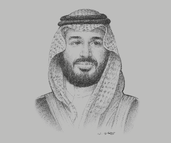Crown Prince Mohammed bin Salman bin Abdulaziz Al Saud: Viewpoint

Viewpoint: Mohammed bin Salman bin Abdulaziz Al Saud
In the nearly three years since Vision 2030 was launched, Saudi Arabia has made great strides towards developing and diversifying its economy. Many sectors and government institutions have been restructured and upgraded, and economic and social reforms have been implemented across the board, notably in the cultural, entertainment and sporting segments.
The numbers that have emerged since the country entered this phase of fast-paced development speak for themselves, and they are changing every day for the better. While Saudi Arabia’s non-oil revenues have increased nearly three-fold since 2016, the country is also enjoying steady growth in non-oil exports, which rose from 2.2% in 2017 to 2.5% in 2018. Our expectations are high, and we are confident that these figures will continue growing until we meet our 2030 objectives. In terms of global competitiveness, Saudi Arabia’s position has also been improving annually.
In January 2019 the launch of the National Industrial Development and Logistics Programme (NIDLP) marked a new beginning for increased localisation of our industrial capabilities and in-country manufacturing facilities. The programme aims to boost investment in key sectors like mining, industry, energy and logistics, and is currently worth more than $453bn. By 2030 this programme alone is expected to add 1.6m jobs to the labour market. Indeed, the NIDLP is a cornerstone for creating employment opportunities and increasing the value of Saudi non-oil exports in the long term.
Saudi Arabia’s fiscal budget for 2019 is set at more than SR1trn ($266.6bn), which is the largest in the history of the country and represents a roughly 7% increase above spending in 2018. The budget for 2020 will continue this trend and will be bigger still. We also find that the government spending rate, including both capital and operational expenditures, is increasing significantly, while the salaries of public sector workers are decreasing. In 2016 salaries made up 50% of the government budget; in 2019 we expect this rate to reach a record low of 45%. We also strongly believe that the unemployment rate will continue to improve on a yearly basis until it declines to 7% in 2030.
Through the Public Investment Fund (PIF), Saudi Arabia has been establishing one of the largest sovereign wealth funds in the world. Assets under the PIF’s management totalled $300bn in 2018 and are expected to grow to over $400bn in 2019. Our objective for the PIF is for it to reach $2trn by 2030.
The PIF focuses on strategic and high-yield investments across a wide variety of sectors, both inside and outside the Kingdom of Saudi Arabia. To support the growth of the private and non-oil sectors, the PIF is expected to raise capital by releasing an equity stake that it currently holds in the publicly traded petrochemicals manufacturer Saudi Arabian Basic Industries, which is scheduled to be acquired by Saudi Aramco, the state-owned oil giant.
All the mega- and giga-projects that have been launched since 2016 under Vision 2030 are well under way, including Neom, the Red Sea Project and Al Qiddiya project. Those projects are unique to Saudi Arabia, but business opportunities are to be found for the Kingdom across the region as well.
For a long time Middle Eastern countries focused on natural resource extraction. Then the UAE, including both Dubai and Abu Dhabi, began to show the world that the creation of a new development model is possible. Blessed with strong financial reserves and talented human resources, our countries have already recorded great achievements, and there are definitely more opportunities ahead that are yet to be seized. The countries and economies of the Middle East are intrinsically connected through historical, intraregional trade flows and even cultures. Many of our neighbours, such as Egypt, Oman, Bahrain and Kuwait – not to mention the Kingdom itself – will be very different places in five years, and increased economic cooperation between our countries can only be beneficial in the long term.
You have reached the limit of premium articles you can view for free.
Choose from the options below to purchase print or digital editions of our Reports. You can also purchase a website subscription giving you unlimited access to all of our Reports online for 12 months.
If you have already purchased this Report or have a website subscription, please login to continue.

